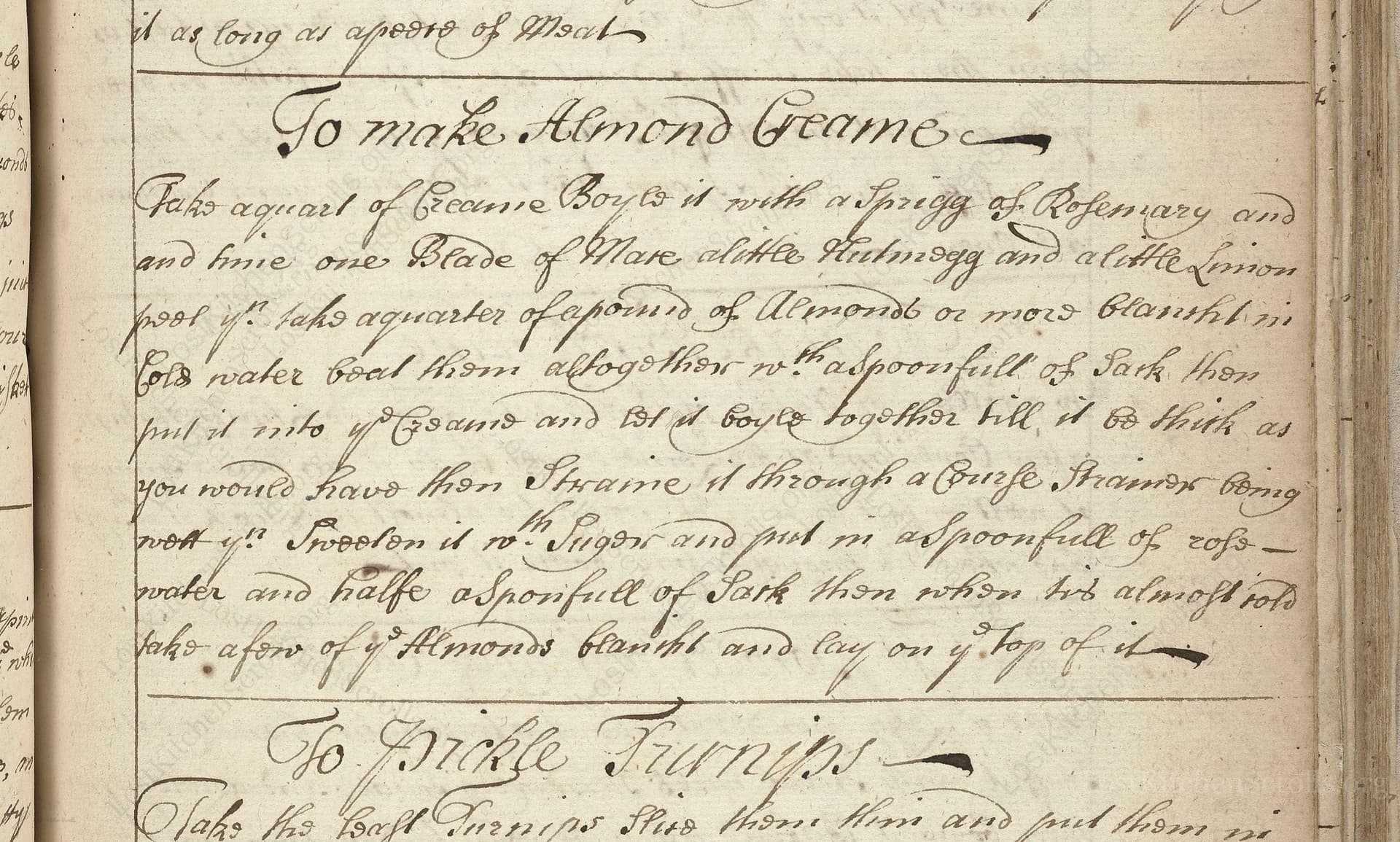To Make Almond Creame
From the treasured pages of Cookbook of Grace Blome, Kent
Written by Grace Randolph

To Make Almond Creame
"Take a quart of Creame Boyle it with a sprigg of Rosemary and and one blade of Mace a little Nutmegg and a little Lemon peel yr take a quarter of a pound of Almonds or more blancht in cold water beat them altogether now put it into yr Creame and let it boyle together till it be thick as you would have then straine it through a Course Strainer being wett yn Sweeten it with Suger and put in a spoonfull of rose-water and halfe a spoonfull of Sack then when tis almost cold take a few of ye Almonds blanched and lay on ye top of it"
Note on the Original Text
Seventeenth-century English recipes were written as practical memory aids, often lacking precise measurements or temperatures. Ingredient quantities like 'a quart of Creame' or 'a quarter of a pound of Almonds' reflected standard market measures of the time. Spelling was fluid—'Creame,' 'Suger,' and 'boyle' were common variants. Directions were continuous, assuming the reader's knowledge of basic kitchen processes, and details like straining or sweetening were added as afterthoughts.

Title
Cookbook of Grace Blome, Kent (1697)
You can also click the book image above to peruse the original tome
Writer
Grace Randolph
Era
1697
Publisher
Unknown
Background
A delightful glimpse into late 17th-century kitchens, this culinary collection by Grace Randolph tempts taste buds with refined recipes and elegant flavors fit for a well-to-do English household. Journey through a banquet of historic treats and timeless techniques!
Kindly made available by
Folger Shakespeare Library
This recipe comes from the late 17th century, a period where almond-based creams and custards were popular in English households, especially among the upper classes. Scented with exotic spices and aromatics, such desserts showcased both wealth and access to imported ingredients. Grace Randolph, whose handwritten recipe book (dated 1697) preserves this dish, was likely a literate woman of some means, chronicling refined recipes for family and friends. Almond cream like this would have graced banquet tables or been served for special occasions.

Cooks in Randolph's day would have used a cauldron or heavy-bottomed pot set over a wood or coal fire, with ladles or wooden spoons for stirring. Almonds would be pounded in a large mortar with a pestle, or ground on a stone. Straining was typically done with cloth- or hair-lined sieves, wetted beforehand to prevent waste. Bowls of pewter or ceramic would be used for chilling and serving.
Prep Time
20 mins
Cook Time
20 mins
Servings
6
We've done our best to adapt this historical recipe for modern kitchens, but some details may still need refinement. We warmly welcome feedback from fellow cooks and culinary historians — your insights support the entire community!
Ingredients
- 1 quart heavy cream (36-40% fat)
- 1 small sprig fresh rosemary
- 1/2 teaspoon ground mace or 1 blade mace
- Pinch of freshly grated nutmeg
- 2 inch strip of lemon peel (no pith)
- 4 ounces blanched almonds (plus extra for garnish)
- Cold water (for blanching/grinding)
- 2-3 tablespoons caster sugar, or to taste
- 1 tablespoon rosewater
- 1/2 tablespoon (0.25 fl oz or 1 1/2 teaspoons) sweet sherry (substitute for sack)
Instructions
- Begin by gently heating 1 quart of heavy cream with one small sprig of fresh rosemary, one blade (about 1/2 teaspoon, crushed) of mace, a pinch of freshly grated nutmeg, and a strip (about 2 inches) of lemon peel.
- Bring the mixture just to a simmer, infusing the flavors.
- Meanwhile, blanch 4 ounces of almonds by pouring boiling water over them, then slipping off their skins.
- Then, grind the almonds finely in a food processor or mortar and pestle, with a little cold water to form a thick paste.
- Add the almond paste to the hot cream mixture and continue to simmer gently, stirring frequently, until the mixture thickens to your desired consistency (think of a loose custard).
- Strain the mixture through a coarse sieve or fine-mesh strainer that you have first rinsed with cold water, discarding any solids.
- While the cream is still warm, sweeten to taste with caster sugar (about 2-3 tablespoons), stir in one tablespoon of rosewater and half a tablespoon (about 0.25 fluid ounces or 1 1/2 teaspoons) of sweet sherry or dessert wine (as substitute for sack).
- Allow to cool, then, before serving, top with a few additional blanched almonds for garnish.
Estimated Calories
350 per serving
Cooking Estimates
Preparing this dish takes about 20 minutes, including blanching and grinding the almonds. Cooking takes about 20 minutes as you slowly heat and thicken the cream mixture. Each serving has approximately 350 calories, and the recipe makes 6 servings.
As noted above, we have made our best effort to translate and adapt this historical recipe for modern kitchens, taking into account ingredients nowadays, cooking techniques, measurements, and so on. However, historical recipes often contain assumptions that require interpretation.
We'd love for anyone to help improve these adaptations. Community contributions are highly welcome. If you have suggestions, corrections, or cooking tips based on your experience with this recipe, please share them below.
Join the Discussion
Rate This Recipe
Dietary Preference
Main Ingredients
Culinary Technique
Occasions

Den Bockfisch In Einer Fleisch Suppen Zu Kochen
This recipe hails from a German manuscript cookbook compiled in 1696, a time whe...

Die Grieß Nudlen Zumachen
This recipe comes from a rather mysterious manuscript cookbook, penned anonymous...

Ein Boudain
This recipe comes from an anonymous German-language manuscript cookbook from 169...

Ein Gesaltzen Citroni
This recipe, dating from 1696, comes from an extensive anonymous German cookbook...
Browse our complete collection of time-honored recipes



